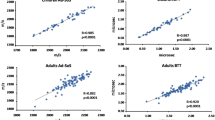Abstract
Skeletal status by phalangeal quantitative osteosonography (DBM Sonic BP - IGEA) was examined in 1227 healthy children (641 boys and 586 girls) aged 3–16 years. Aims of the study were to evaluate some physical parameters pertaining to the ultrasound transmission crossing the phalanx in a school-age population and to relate these values to age, sex, and growth variables. A correlation was found between AD-SoS (amplitude-dependent speed of sound) and BTT (bone transmission time) and, age, height, weight, and pubertal stage, respectively. No correlation existed between FWA (fast wave amplitude) and SDy (dynamics of the ultrasound signal) and age, height, weight, pubertal stage, and BMI, respectively. AD-SoS increased in boys until 7–8 years of age. Thereafter a plateau was reached up to age 12–13 years, when a rapid increase was observed corresponding to pubertal growth rate acceleration. In girls, AD-SoS increased with age up to 10–11 years with a steeper increase at the time of puberty starting about 2 years earlier than in boys. BTT presented a similar trend. Mean AD-SoS values increased from Tanner pubertal stages 1 to 2 and from stage 3 to 4 in both sexes. Significantly higher mean AD-SoS values in stages 2, 3, and 4 were observed in girls as compared to boys. Mean BTT values increased significantly from stage 1 to 5 in girls and from 1 to 4 in boys. QUS technology showed the ability to assess bone changes in the growing bone.






Similar content being viewed by others
References
Z Halaba W Pluskiewicz (1997) ArticleTitleThe assessment of development of bone mass in children by quantitative ultrasound through the proximal phalanxes of the hand. Ultrasound Med Biol 23 1331–1335 Occurrence Handle1:STN:280:DyaK1c%2FovFKjsw%3D%3D Occurrence Handle9428132
GI Baroncelli G Federico S Bertelloni F de Terlizzi R Cadossi G Saggese (2001) ArticleTitleBone quality assessment by quantitative ultrasound of proximal phalanxes of the hand in healthy subjects aged 3–21 years. Pediatr Res 49 713–718 Occurrence Handle1:STN:280:DC%2BD3MzntVKgsw%3D%3D Occurrence Handle11328957
J Gimeno Ballester C Azcona San Julian L Sierrasesumaga Ariznabarreta (2001) ArticleTitleBone mineral density determination by osteosonography in healthy children and adolescents: normal values. An Esp Pediatr 54 540–546 Occurrence Handle1:STN:280:DC%2BD38%2FhsV2qsA%3D%3D Occurrence Handle11412400
R Barkmann W Rohrschneider M Vierling J Tröger F de Terlizzi R Cadossi M Heller C Glüer (2002) ArticleTitleGerman pediatric reference data for quantitative transverse transmission ultrasound of finger phalanges. Osteoporos Int 13 55–61 Occurrence Handle1:STN:280:DC%2BD387ksVGlsg%3D%3D Occurrence Handle11878455
C Wuster C Albanese D De Aloysio F Duboeuf M Gambacciani S Gonnelli CC Glüer D Hans J Joly JY Reginster F De Terlizzi R Cadossi (2000) ArticleTitlePhalangeal osteosonogrammetry study: age-related changes, diagnostic sensitivity, and discrimination power. The Phalangeal Osteosonogrammetry Study Group. J Bone Miner Res 15 1603–1614 Occurrence Handle10934660
R Barkmann S Lüsse B Stampa S Sakata M Heller C Glüer (2000) ArticleTitleAssessment of the geometry of human finger phalanges using quantitative ultrasound in vivo. Osteoporos Int 11 745–755 Occurrence Handle10.1007/s001980070053 Occurrence Handle1:STN:280:DC%2BD3M7hs1aqsQ%3D%3D Occurrence Handle11148802
CF Njeh A Richards CM Boivin D Hans T Fuerst HV Genant (1999) ArticleTitleFactors influencing the speed of sound through the proximal phalanges. J Clin Densitom 2 241–249 Occurrence Handle1:STN:280:DC%2BD3c%2FhvVCktA%3D%3D Occurrence Handle10548820
WS Pollitzer JJ Anderson (1989) ArticleTitleEthnic and genetic differences in bone mass: a review with a hereditary vs environmental perspective. Am J Clin Nutr 50 1244–1259 Occurrence Handle1:STN:280:By%2BD1cnmt1c%3D Occurrence Handle2688394
JM Tanner RH Whitehouse (1976) ArticleTitleClinical longitudinal standard of height, weight, height velocity, weight velocity and the stages of puberty. Arch Dis Child 51 170–179 Occurrence Handle1:STN:280:CSmB2M7mslI%3D Occurrence Handle952550
PM Duke IF Litt RT Gross (1980) ArticleTitleAdolescents’ self assessment of sexual maturation. Pediatrics 66 918–920 Occurrence Handle1:STN:280:Bi6C3c%2FjsVU%3D Occurrence Handle7454482
JPW van den Bergh C Noordam A Özyilmaz ARMM Hermus AGH Smals BJ Otten (2000) ArticleTitleCalcaneal utrasound imaging in healthy children and adolescents: relation of the ultrasound parameters BUA and SOS to age, body weight, height, foot dimensions, and pubertal stage. Osteoporos Int 11 967–976 Occurrence Handle11193250
MH Lequin RR van Rijn SG Robben WC Hop C van Kuijk (2000) ArticleTitleNormal values for tibial quantitative ultrasonometry in Caucasian children and adolescents (aged 6 to 19 years). Calcif Tissue Int 67 101–105 Occurrence Handle1:CAS:528:DC%2BD3cXmtFCjtr8%3D Occurrence Handle10920212
C Glastre P Braillon L David P Cochat PJ Meunier PD Delmas (1990) ArticleTitleMeasurement of bone mineral content of the lumbar spine by dual energy x-ray absorptiometry in normal children: correlations with growth parameters. J Clin Endocrinol Metab 70 1330–1333 Occurrence Handle1:STN:280:By%2BB2czotlU%3D Occurrence Handle2335574
C Molgaard BL Thomsen KF Michaelsen (1998) ArticleTitleInfluence of weight, age and puberty on bone size and bone mineral content in healthy children and adolescents. Acta Paediatr 87 494–499 Occurrence Handle10.1080/08035259850158173 Occurrence Handle1:STN:280:DyaK1czgtlCgsg%3D%3D Occurrence Handle9641728
L del Rio A Carrascosa F Pons M Gusinye D Yeste FM Domenech (1994) ArticleTitleBone mineral density of the lumbar spine in white Mediterranean Spanish children and adolescents: changes related to age, sex, and puberty. Pediatr Res 35 362–366
AM Boot MA de Ridder HA Pols EP Krenning SM de Muinck Keizer-Schrama (1997) ArticleTitleBone mineral density in children and adolescents: relation to puberty, calcium intake, and physical activity. J Clin Endocrinol Metab 82 57–62 Occurrence Handle1:CAS:528:DyaK2sXkt1SnsA%3D%3D Occurrence Handle8989233
Acknowledgements
We are grateful to A. Capurro, L. Boccaccio, school teachers and parents who gave their consent to the study. The authors thank children, school teachers, and parents who participated in this study.
Author information
Authors and Affiliations
Corresponding author
Rights and permissions
About this article
Cite this article
Vignolo, M., Brignone, A., Mascagni, A. et al. Influence of Age, Sex, and Growth Variables on Phalangeal Quantitative Ultrasound Measures: A Study in Healthy Children and Adolescents . Calcif Tissue Int 72, 681–688 (2003). https://doi.org/10.1007/s00223-002-2028-z
Received:
Accepted:
Published:
Issue Date:
DOI: https://doi.org/10.1007/s00223-002-2028-z




